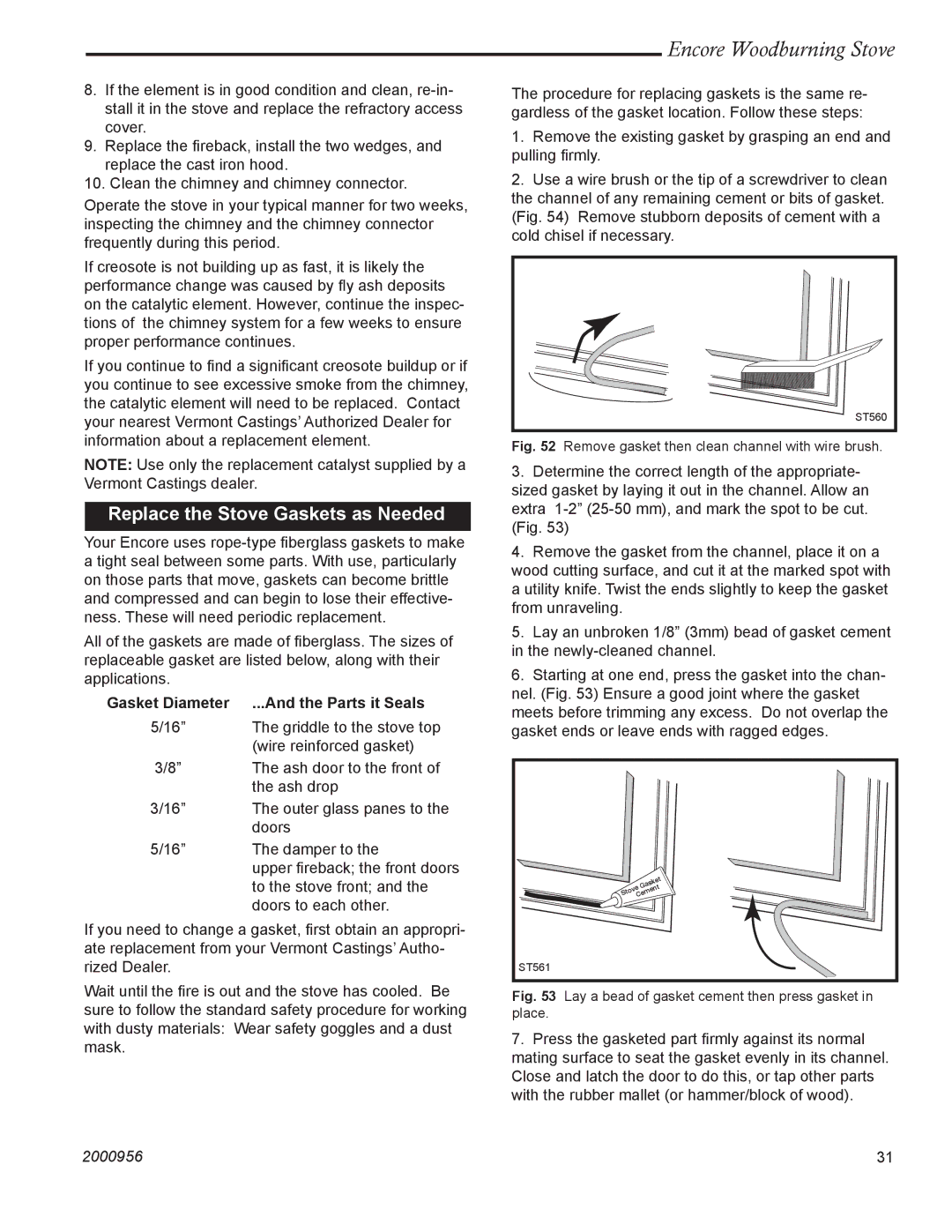
8.If the element is in good condition and clean,
9.Replace the fireback, install the two wedges, and replace the cast iron hood.
10.Clean the chimney and chimney connector.
Operate the stove in your typical manner for two weeks, inspecting the chimney and the chimney connector frequently during this period.
If creosote is not building up as fast, it is likely the performance change was caused by fly ash deposits on the catalytic element. However, continue the inspec- tions of the chimney system for a few weeks to ensure proper performance continues.
If you continue to find a significant creosote buildup or if you continue to see excessive smoke from the chimney, the catalytic element will need to be replaced. Contact your nearest Vermont Castings’ Authorized Dealer for information about a replacement element.
NOTE: Use only the replacement catalyst supplied by a Vermont Castings dealer.
Replace the Stove Gaskets as Needed
Your Encore uses
All of the gaskets are made of fiberglass. The sizes of replaceable gasket are listed below, along with their applications.
Gasket Diameter ...And the Parts it Seals
5/16” The griddle to the stove top (wire reinforced gasket)
3/8” The ash door to the front of
the ash drop
3/16” The outer glass panes to the doors
5/16” The damper to the
upper fireback; the front doors to the stove front; and the doors to each other.
If you need to change a gasket, first obtain an appropri- ate replacement from your Vermont Castings’ Autho- rized Dealer.
Wait until the fire is out and the stove has cooled. Be sure to follow the standard safety procedure for working with dusty materials: Wear safety goggles and a dust mask.
Encore Woodburning Stove
The procedure for replacing gaskets is the same re- gardless of the gasket location. Follow these steps:
1.Remove the existing gasket by grasping an end and pulling firmly.
2.Use a wire brush or the tip of a screwdriver to clean the channel of any remaining cement or bits of gasket. (Fig. 54) Remove stubborn deposits of cement with a cold chisel if necessary.
| ST560 |
Fig. 52 | Remove gasket then clean channel with wire brush. |
3.Determine the correct length of the appropriate- sized gasket by laying it out in the channel. Allow an extra
4.Remove the gasket from the channel, place it on a wood cutting surface, and cut it at the marked spot with a utility knife. Twist the ends slightly to keep the gasket from unraveling.
5.Lay an unbroken 1/8” (3mm) bead of gasket cement in the
6.Starting at one end, press the gasket into the chan- nel. (Fig. 53) Ensure a good joint where the gasket meets before trimming any excess. Do not overlap the gasket ends or leave ends with ragged edges.
| Gasket |
| ve |
| Sto Cement |
ST561 |
|
Fig. 53 | Lay a bead of gasket cement then press gasket in |
place. |
|
7.Press the gasketed part firmly against its normal mating surface to seat the gasket evenly in its channel. Close and latch the door to do this, or tap other parts with the rubber mallet (or hammer/block of wood).
2000956 | 31 |
